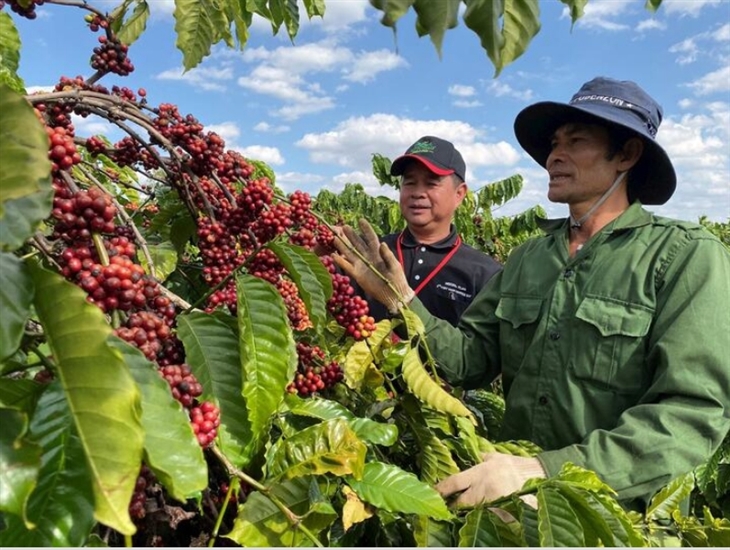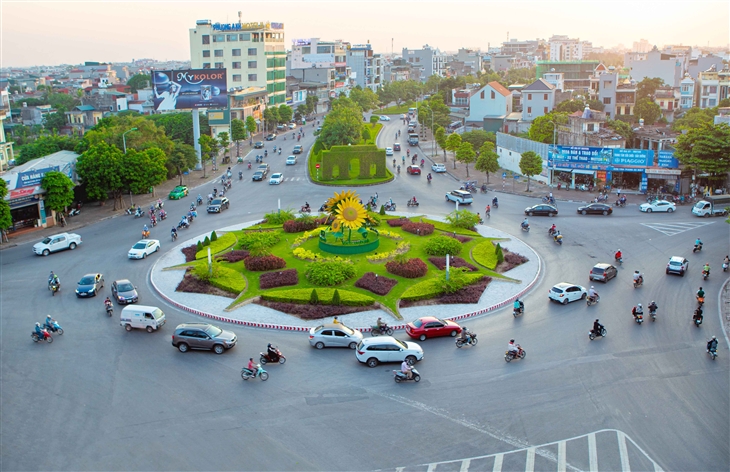Coffee farmers stuck under EUDR regulations due to lack of documents, difficult to trace
Friday, July 18,2025
AsemconnectVietnam - To meet EUDR regulations, coffee farmers are facing great difficulties in proving land use rights and tracing the origin of products.
Farmers, the 'backbone' of Vietnam's coffee industry
With a supply accounting for over 95% of the total coffee supply of the industry, farmers play a particularly important role in the supply chain of Vietnam's coffee industry. Currently, there are over 600,000 households participating in coffee production, with over 90% of the coffee area of the industry's total area of over 700,000 hectares coming from households. Most of these areas are concentrated in the Central Highlands region where coffee is traditionally produced; a small part of the area has been newly developed in the Northwest in recent decades.
About 90% of Vietnam's coffee is for export. EU is the most important market for Vietnam's coffee industry, with 40% of Vietnam's coffee being exported to this market. In 2023, European Union issued EU Deforestation Reduction Regulation (EUDR), which requires seven agricultural and forestry products, including coffee, exported to this market to ensure legality, not causing deforestation and ensuring traceability.
Products that do not meet these requirements will be refused import. Meeting the requirements of the EUDR is vital to the Vietnamese coffee industry. EUDR will officially take effect at the end of 2025.
According to report "Vietnamese coffee farmers with ability to meet EUDR regulations" conducted by Forest Trends in collaboration with TAVINA, a survey of 95 coffee growing households in the Central Highlands and Son La showed that coffee contributes up to 78.8% of household income, equivalent to nearly 590 million VND per year. However, households face many barriers in meeting the EUDR.
One of the biggest obstacles is the legality of land use. Household coffee cultivation areas are generally small and scattered. On average, each household owns about 1.3 hectares, most of which are divided into many small plots. About 34% of households have less than 1 hectare, 61% have less than 2 hectares and on average each household has nearly 2 plots.
Notably, 96% of household plots growing coffee were cultivated by households before 2020. 26% of household plots growing coffee were cultivated before 2000. The distance from the production plot to the edge of the forest is one of the criteria for assessing risks in coffee production and deforestation.
About 10% of household plots growing coffee are less than 300 m from the forest and are considered at high risk of deforestation. 86% of the surveyed plots were low risk (distance from plot to forest over 500 m) and 4% were medium risk (distance from 300 to 500 m).
However, most plots considered high risk had land use right certificates, which are the basis for ensuring that the household is the legal cultivator on the plot. This reduces the risk of deforestation in land use.
Regarding traceability, many households have not fully recorded the process of harvesting, storing and selling products. Nearly 54% of households did not record; of the remaining, the records were not separated by plot or harvest period, making it difficult to check and trace according to EUDR requirements.
The survey also pointed out a clear difference between Kinh households and ethnic minority households in terms of land legality. Up to 82% of Kinh households' land plots have red books, while this figure for ethnic households is only 55%. In addition, the distance from the land plot to the edge of the forest of ethnic households (4.6 km) is also much closer than that of Kinh households (9.9 km), posing a higher risk of violating EUDR regulations.
Enterprises and authorities need to accompany farmers
In an interview with a reporter from the Industry and Trade Newspaper, Dr. To Xuan Phuc, Director of the Forest Policy, Finance and Trade Program of the Forest Trends Organization, said that the current situation of coffee production of households shows that many problems at the household level need to be solved to meet the requirements of the EUDR.
These problems exist in different stages, especially in the stage of land use by households. Lack of evidence proving that the household is a legal entity in land use, the household complies with land laws in land use, lack of information on the location of the production plot, the small distance from the production plot to the forest or the production plot is located on the land area planned as forestry land... are the main problems in this stage. In addition, there is currently a lack of a traceability system in the stage of product collection and storage and in the household's product sales activities. These problems hinder the household's compliance with EUDR requirements.
To meet market requirements, households need special support from stakeholders, especially from stakeholders currently participating in the chain with households. Support includes training and dissemination of information, especially supporting households in implementing traceability activities. Training and support for households need to ensure that information and knowledge are closest to households, so that households can easily access them.
Participants in the supply chain, especially businesses participating in linkages with households, need to identify households as an inseparable part of their business model, thereby identifying that helping households in ensuring that they comply with the law and carry out traceability activities is the responsibility of the business.
Local management agencies need to help households in determining the origin of land, background information on the status of forest resources and other necessary support in terms of information and technology to ensure that households meet the requirements of new market regulations.
Information and forms of support for households in meeting the EUDR need to take into account the differences in the ethnic composition of coffee growing households and the local factors. Focusing resources on supporting these groups of households and localities will help to improve the capacity of these households and localities, in order to reduce the difficulties for households and reduce the risk of being eliminated from the supply chain.
Source: Vitic/ congthuong.vn
With a supply accounting for over 95% of the total coffee supply of the industry, farmers play a particularly important role in the supply chain of Vietnam's coffee industry. Currently, there are over 600,000 households participating in coffee production, with over 90% of the coffee area of the industry's total area of over 700,000 hectares coming from households. Most of these areas are concentrated in the Central Highlands region where coffee is traditionally produced; a small part of the area has been newly developed in the Northwest in recent decades.
About 90% of Vietnam's coffee is for export. EU is the most important market for Vietnam's coffee industry, with 40% of Vietnam's coffee being exported to this market. In 2023, European Union issued EU Deforestation Reduction Regulation (EUDR), which requires seven agricultural and forestry products, including coffee, exported to this market to ensure legality, not causing deforestation and ensuring traceability.
Products that do not meet these requirements will be refused import. Meeting the requirements of the EUDR is vital to the Vietnamese coffee industry. EUDR will officially take effect at the end of 2025.
According to report "Vietnamese coffee farmers with ability to meet EUDR regulations" conducted by Forest Trends in collaboration with TAVINA, a survey of 95 coffee growing households in the Central Highlands and Son La showed that coffee contributes up to 78.8% of household income, equivalent to nearly 590 million VND per year. However, households face many barriers in meeting the EUDR.
One of the biggest obstacles is the legality of land use. Household coffee cultivation areas are generally small and scattered. On average, each household owns about 1.3 hectares, most of which are divided into many small plots. About 34% of households have less than 1 hectare, 61% have less than 2 hectares and on average each household has nearly 2 plots.
Notably, 96% of household plots growing coffee were cultivated by households before 2020. 26% of household plots growing coffee were cultivated before 2000. The distance from the production plot to the edge of the forest is one of the criteria for assessing risks in coffee production and deforestation.
About 10% of household plots growing coffee are less than 300 m from the forest and are considered at high risk of deforestation. 86% of the surveyed plots were low risk (distance from plot to forest over 500 m) and 4% were medium risk (distance from 300 to 500 m).
However, most plots considered high risk had land use right certificates, which are the basis for ensuring that the household is the legal cultivator on the plot. This reduces the risk of deforestation in land use.
Regarding traceability, many households have not fully recorded the process of harvesting, storing and selling products. Nearly 54% of households did not record; of the remaining, the records were not separated by plot or harvest period, making it difficult to check and trace according to EUDR requirements.
The survey also pointed out a clear difference between Kinh households and ethnic minority households in terms of land legality. Up to 82% of Kinh households' land plots have red books, while this figure for ethnic households is only 55%. In addition, the distance from the land plot to the edge of the forest of ethnic households (4.6 km) is also much closer than that of Kinh households (9.9 km), posing a higher risk of violating EUDR regulations.
Enterprises and authorities need to accompany farmers
In an interview with a reporter from the Industry and Trade Newspaper, Dr. To Xuan Phuc, Director of the Forest Policy, Finance and Trade Program of the Forest Trends Organization, said that the current situation of coffee production of households shows that many problems at the household level need to be solved to meet the requirements of the EUDR.
These problems exist in different stages, especially in the stage of land use by households. Lack of evidence proving that the household is a legal entity in land use, the household complies with land laws in land use, lack of information on the location of the production plot, the small distance from the production plot to the forest or the production plot is located on the land area planned as forestry land... are the main problems in this stage. In addition, there is currently a lack of a traceability system in the stage of product collection and storage and in the household's product sales activities. These problems hinder the household's compliance with EUDR requirements.
To meet market requirements, households need special support from stakeholders, especially from stakeholders currently participating in the chain with households. Support includes training and dissemination of information, especially supporting households in implementing traceability activities. Training and support for households need to ensure that information and knowledge are closest to households, so that households can easily access them.
Participants in the supply chain, especially businesses participating in linkages with households, need to identify households as an inseparable part of their business model, thereby identifying that helping households in ensuring that they comply with the law and carry out traceability activities is the responsibility of the business.
Local management agencies need to help households in determining the origin of land, background information on the status of forest resources and other necessary support in terms of information and technology to ensure that households meet the requirements of new market regulations.
Information and forms of support for households in meeting the EUDR need to take into account the differences in the ethnic composition of coffee growing households and the local factors. Focusing resources on supporting these groups of households and localities will help to improve the capacity of these households and localities, in order to reduce the difficulties for households and reduce the risk of being eliminated from the supply chain.
Source: Vitic/ congthuong.vn
Meeting EUDR regulations: Wide door for rubber industry enterprises to enter EU market
Vietnam ranks third in in cassava exports all over the world
Industry, import and export continue to thrive in first half of 2025
Daily: Domestic rice prices increased slightly on July 17, 2025
Daily: Domestic pepper prices dicreased by 1,000 VND on July 17, 2025
Daily: Domestic coffee prices incresead slightly on July 17, 2025
South Korea still main market for Vietnam’s squid and octopus
Vietnam exempted from temporary safeguard duties in exporting steel coils to South Africa
Daily: Domestic rice prices increased slightly on July 16, 2025
Daily: Domestic pepper prices up by VND1,000/kg as inventories hit historic lows on July 16, 2025
Daily: Domestic coffee prices decreased on July 16, 2025
30 years of Vietnam - US relations: Trade turnover grows 300 times
Singapore imports about 2.5 million USD/year of milk and dairy products from Vietnam
5 years of implementing EVFTA: Agricultural, forestry and fishery exports benefit greatly

Plan of Hai Duong province for a period of 2021 - 2030, ...
Organize space reasonably and harmoniously, focusing on connecting Hai Duong in common development space, actively contributing to the ...Plan of Hau Giang province in a period of 2021 - 2030, ...
Sustainable forestry development program in a period of ...

AI opens new path for image industry: Insiders
Though the term "image industry" remains relatively new in the local context, the development of a creative ecosystem driven by AI will ...Hanoi’s street food culture gains ground with Michelin nods
Draw held for 2025 Davis Cup Asia/Oceania Group III in Bac ...
Da Nang Museum opens an exhibition of rare ancient ...
An Giang races to complete UNESCO nomination dossier for ...



